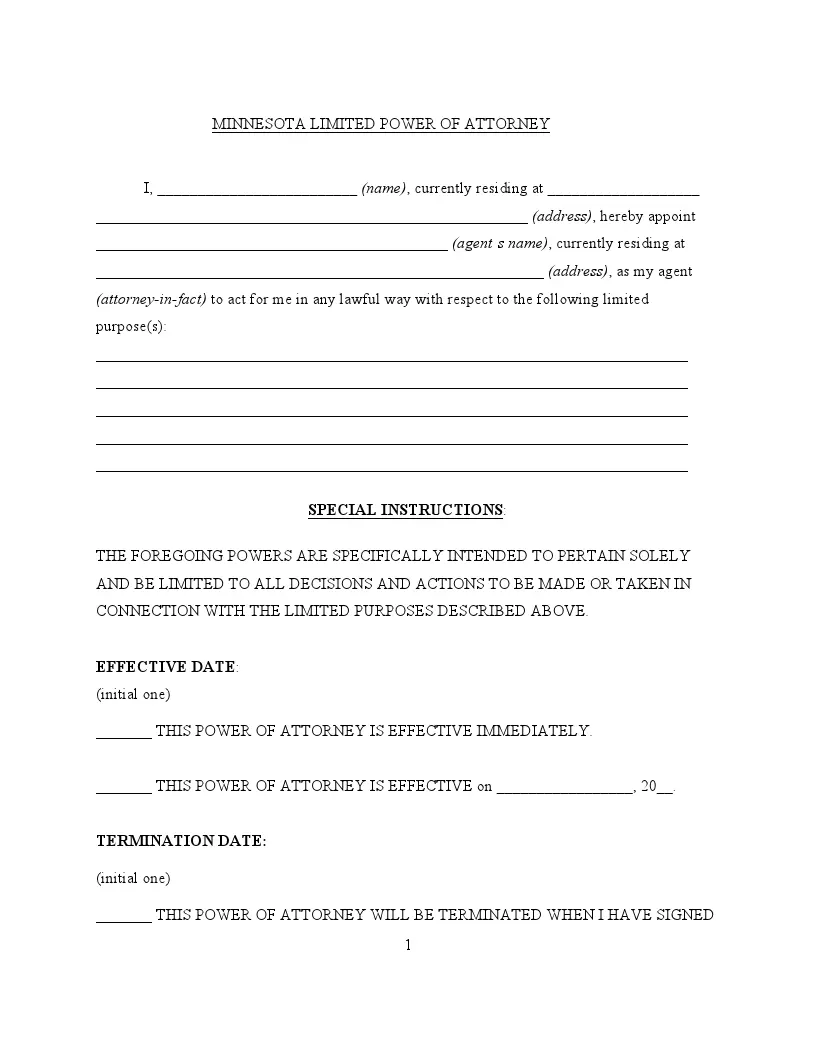Minnesota Limited Power of Attorney Form
The Minnesota limited power of attorney form is a specialized legal document that permits a person (principal) to appoint someone else (agent or attorney-in-fact) to carry out designated duties on their behalf. This form differs from a general power of attorney by limiting the agent’s powers to specific activities or circumstances. The scope of authority granted can vary widely, depending on the principal’s preferences, but it is always limited to defined scenarios or responsibilities.
A limited power of attorney is frequently used for particular financial dealings, property transactions, or other legal issues when the principal cannot attend in person but requires representation. According to Minnesota law, this form must detail the powers bestowed and the principal and agent identities. The document must also be notarized to be recognized as legally valid, confirming its acceptance by other parties and legal institutions.
Consider using other Minnesota power of attorney forms tailored to comply with state laws to effectively manage all your affairs.

Build Your Document
Answer a few simple questions to make your document in minutes
Save and Print
Save progress and finish on any device, download and print anytime
Sign and Use
Your valid, lawyer-approved document is ready
Under Minnesota law, specifically Chapter 523 of the Minnesota Statutes, a limited power of attorney must be executed precisely to ensure its legality. The statute defines a “power of attorney” as a document that is validly executed and adheres to specified legal standards. When preparing a limited power of attorney, the following requirements must be met:
- Signature by the principal, on their behalf by another individual, or by making a mark.
- Acknowledgment by a notary public.
Further, it is essential to explicitly state the powers delegated to the agent and identify both the principal and agent in the document. Although not mandatory, it is strongly advised to have the document notarized even if the principal can sign it themselves. This notarization ensures that the power of attorney is recognized as valid and enforceable in legal and transactional settings, as prescribed by § 523.01 of the Minnesota Statutes.
Minnesota Limited Power of Attorney Form Details
| Document Name | Minnesota Limited Power of Attorney Form |
| Other Name | Minnesota Special Power of Attorney |
| Relevant Laws | Minnesota Statutes, Section 523.01 |
| Avg. Time to Fill Out | 8 minutes |
| # of Fillable Fields | 32 |
| Available Formats | Adobe PDF |
Filling Out Minnesota Limited POA
Filling out a limited power of attorney form in Minnesota involves specifying who will act on your behalf and detailing the powers you are delegating. This document must be completed accurately to ensure it’s legally binding and reflects your intentions.
1. Enter Principal’s Details
Begin by entering your full name where indicated as the principal — the person granting the power of attorney. You will also need to include your social security number, although be cautious and ensure this information is kept secure.
2. Appoint Your Attorney-in-Fact
In the next section, specify the full name and address of the person you are appointing as your attorney-in-fact. This individual will have the authority to act on your behalf.
3. Define the Powers Granted
Detail the specific powers you are granting to your attorney-in-fact. Be as clear and precise as possible to avoid any ambiguity. List the acts they are authorized to perform on your behalf. It’s important to tailor this section specifically to your needs, ensuring you only give authority for tasks you require.
4. Acknowledge Fiduciary Responsibility
Acknowledge that your attorney-in-fact agrees to act in your best interest according to the terms of the power of attorney. This section confirms the attorney-in-fact’s acceptance of their fiduciary duties.
5. Sign and Date the Form
Enter the date you are signing the form, and then sign your name to affirm that the information provided and the powers granted are as you intend.
6. Notarization
The form must be notarized to be legally effective. This part involves signing the document in front of a notary public. The notary will then fill out the state and county, apply their seal, and sign the form to certify that you have acknowledged and sworn to the contents of the power of attorney in their presence.
7. Store and Share the Document
Once notarized, make copies of the power of attorney. Keep the original safe and provide copies to your attorney-in-fact and any institutions or individuals needing it to recognize the powers granted.
